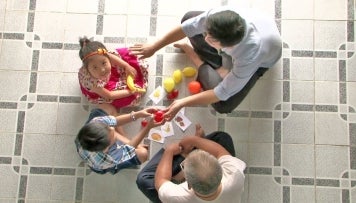
Over 2,000 primary school deaf students in Vietnam are targeted for a better education through an improved Vietnamese sign language-based curricula and teacher training, to be made possible through a grant agreement signed on July 29th between the Government of Vietnam and the World Bank. The Global Partnership for Results-Based Approaches (GPRBA), financed by Australia’s Department of Foreign Affairs and Trade (DFAT),is providing US$3 million in funding for this project..
“GPRBA, using its considerable experience in results-based and innovative financing approaches, has designed a project that ensures a better education for deaf students in Vietnam,” said Ms. Maitreyi B. Das, Practice Manager for Urban, Disaster Risk Management, Resilience and Land Global Practice at the World Bank. “Those who before would be taught only in the spoken language of hearing students in the formal education system, will now receive a quality education that better meets their needs by using Vietnamese sign language.”
The objective of the project is to facilitate the integration of deaf children into mainstream and special education through the engagement of parents, caregivers, teachers, and deaf mentors, as well as the community at large. The program’s goals are to increase the proportion of deaf students with access to primary education through Vietnamese sign language (VSL), and to train 500 primary school teachers and teaching assistants to use VSL to teach the subjects of mathematics and Vietnamese.
The project will produce a set of animated video lessons to teach mathematics and Vietnamese language for Grades 1 to 5 to reinforce the development of these improved education methods. It will also triple the number of the VSL lexicon from 2,000 to 6,000 hand gestures. In addition, the project will fund the development of training materials that will help in building the capacity of teachers, teaching assistants, parents, caregivers, and mentors of deaf students.
The project will provide incentives to schools through subsidies for them to enroll deaf children and to teach them using VSL, in line with the government’s policy to increase access to education for children with disabilities. During the project’s first year, 1,500 and 200 deaf children will enroll in specialized and inclusive schools, respectively; the following year, another 300 and 40 students respectively, will enroll in Grade 1, replacing the students graduating Grade 5. Overall, the total number of deaf children enrolled throughout the project life is 2,040.
Both private and public schools in participating provinces will be eligible for the subsidy if they commit to provide VSL-based education services to deaf children. The project will be implemented in the provinces of Bà Rịa - Vũng Tàu, Bắc Kạn, Cà Mau, Cao Bằng, Đắk Lắk, Haiphong, Hanoi, Lâm Đồng, Nam Định, Ninh Thuận, Phú Yên, Quảng Bình, Quảng Ngãi, Son La, Thái Nguyên, Thành phố Hồ Chí Minh, Thừa Thiên - Huế , Tiền Giang, Vĩnh Long, and Yên Bái.
“The World Bank has helped us design a project that has all the components for successful implementation, and we are confident that this has opened a new path for us to improve education opportunities for children with hearing impairment,” said Mr. Nguyễn Hữu Độ, Vice Minister of Education and Training.
This step to “leave no one behind” regarding a quality education is crucial to making opportunities for a better life a reality to this disadvantaged group. Such progress in deaf education is closely related to at least three of the UN Sustainable Development Goals (SDGs) for 2030: to eliminate disparities in education and ensuring equal access for vulnerable populations (SDG4), to promote opportunities for full and productive employment (SDG8), and to reduce inequality within a country and promote social, economic and political inclusion (SDG10). Ultimately, the desired outcome is to build a more solid foundation for hearing-impaired students to more fully integrate into the Vietnamese society and lead independent lives.
Related:









